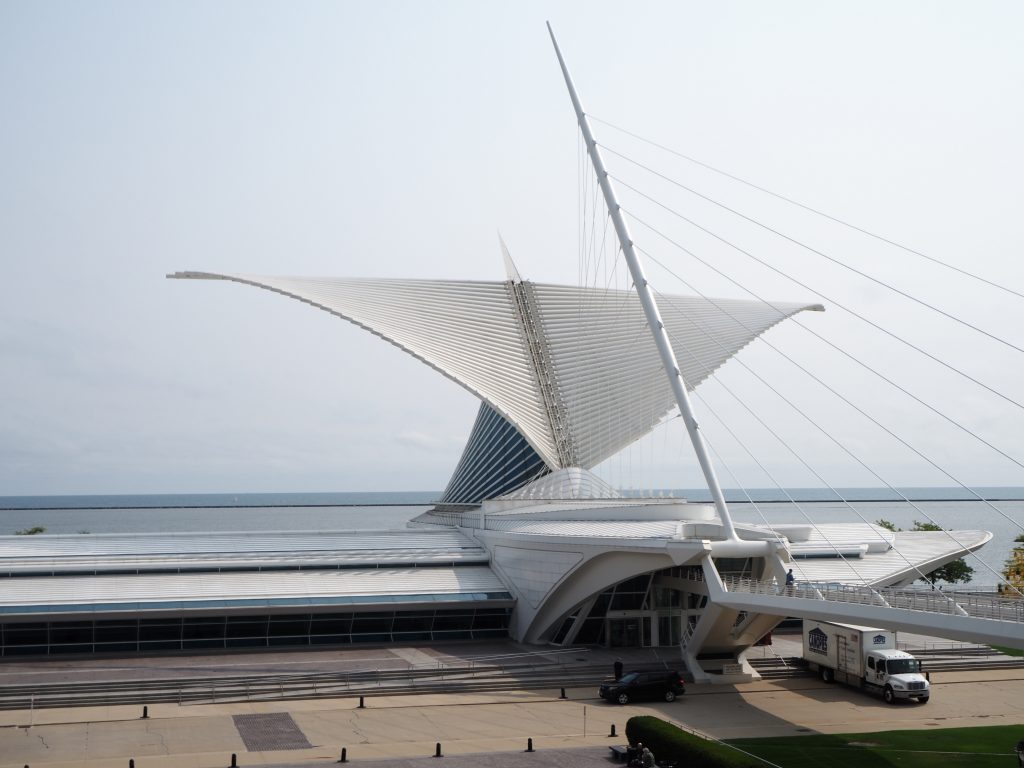How the Calatrava Changed Milwaukee
Good for the city, yes. But how good for the Milwaukee Art Museum?
Last week the Milwaukee Art Museum celebrated the 20th anniversary of the opening of the Calatrava addition to the museum, with Mayor Cavalier Johnson declaring Friday was “Santiago Calatrava Day” in Milwaukee. Milwaukee County Executive David Crowley declared that the impact of Calatrava’s distinctive architecture was “beyond words,” while Johnson said it “jump started Milwaukee’s renaissance,” as Urban Milwaukee reported.
Not a negative word was offered about the addition. Calatrava, ever the ebullient salesman, offered praise for Milwaukee leaders and declared that the addition he built “opened… the city to the lake,” a rather exaggerated claim in a city whose lakefront was long protected and celebrated.
A new generation of wealthy people who were more philanthropic had arisen in Milwaukee by the 1990s, and the museum was the first to prove — dramatically — that really big donor-driven projects could be created in the city. Later efforts like the new Milwaukee Symphony Orchestra music hall built on that success.
The Calatrava addition might be the most breathtaking entryway of any museum in the country. Jim Shields, perhaps the preeminent Milwaukee architect of his generation, once told me he visited the museum repeatedly after the addition was built to study the architecture and was always surprised by some new detail and what there was to learn from it.
There’s no doubt the addition put Milwaukee on the world map in a new way, and was a key step in this city beginning to overcome its reputation as a dreary casualty of the Rust Belt. But for the art museum, the addition has been a mixed blessing at best.
The cost of the addition was originally budgeted at $38 million, but the costs kept rising, and the museum kept raising more money, until the price tag hit $122 million. The museum had originally planned to significantly raise its endowment to help pay for the new building’s upkeep, but that was eaten away by the ever fatter expenses of Calatrava’s creation.
The architect would go on to build project after project with massive cost overruns. An arts complex in Valencia, Spain that was supposed to cost $405 million in US dollars nearly tripled in cost, leaving some city officials fuming. A member of the provincial parliament there created a Web site called Calatravatelaclava, which loosely translates as “Calatrava bleeds you dry.”
A New York Times story noted other disputes involving Calatrava projects: “A Dutch councilor in Haarlemmermeer, near Amsterdam, urged his colleagues to take legal action because the three bridges the architect designed for the town cost twice the budgeted amount and then millions more in upkeep since they opened in 2004.” And Calatrava was threatened with legal action “over a footbridge in Venice, a winery in the Álava region of Spain and a massive exhibition and conference center in Oviedo, Spain.”
Milwaukee, however, was one of the architect’s first major projects, and he charged a much lower fee ($3 million) for his work, versus $127 million for the project in Valencia and $80 million for the Manhattan train station. A 2003 story I did for the Milwaukee Journal Sentinel found the actual cost per square foot was $676 for the museum addition, while other American art museum and museum additions of the era ranged from $239 to $3,735 per square foot.
However, the price for the Milwaukee project was still rising, as it turns out, and eventually hit $130 million, according to two reports, meaning it was not quite the bargain I estimated. Meanwhile, the addition’s impact on the museum’s budget was nearly catastrophic. Its budget was about $6.5 million before the addition was built, but jumped to about $15 million five years after opening, driven by the institution’s growth and added costs of maintenance and security. By the 2018-2019 year, its federal 990 tax form shows the annual budget had grown to $21.2 million.
The new museum has been beset by periodic annual deficits: of $4.6 million in 2010-2011 year and $3.6 million in the 2011-2012 year. A check of its more recent federal tax forms shows a $3.1 million deficit in 2016-17 and $1.4 million in 2019-20, the most recent year for which data is reported.
Before the Calatrava addition the museum had an impressive lineup of shows its own curators created. Since then it has relied far more on touring exhibitions. Its tax forms suggest it is an institution struggling to meet its budget and pay for programming.
The museum had long suffered from the fact that its entrance was at the back of the War Memorial, a problem the Calatrava addition solved, but in the most grandiose and disproportionate way. As critic Martin Filler put it in an analysis for the New York Review of Books, Calatrava’s “preference for bravura effect at the expense of function can also be discerned in the disparity between the Quadracci Pavilion’s extravagant superstructure, which is little more than a lobby, and the dreary exhibition galleries consigned to the concrete box beneath it like some bothersome afterthought.” New York Times critic Nicolai Ouroussoff gave the Calatrava a negative review for the same reason.
And despite Calatrava’s comment about opening the city to Lake Michigan, the post-Calatrava museum had no entrance to the lake. It was left to Milwaukee Art Museum director Dan Keegan to lead a $34 million project completed in 2015 to build a new lakeside entrance and lobby and repair and reboot the portions of the War Memorial Center used by the museum as well as the 1975 addition to the museum by architect David Kahler.
All of which finally has the entire museum facility making more sense, but required still more money for construction while leaving the institution struggling to present the kind of programming that the extraordinary Calatrava lobby leaves you expecting. Those beautiful wings may have helped Milwaukee’s tourism and cultural reputation take flight, but have left the museum itself grounded by never-ending financial struggles.
If you think stories like this are important, become a member of Urban Milwaukee and help support real, independent journalism. Plus you get some cool added benefits.
Political Contributions Tracker
Displaying political contributions between people mentioned in this story. Learn more.
- August 13, 2015 - Cavalier Johnson received $25 from David Crowley
Murphy's Law
-
The Last Paycheck of Don Smiley
 Dec 17th, 2025 by Bruce Murphy
Dec 17th, 2025 by Bruce Murphy
-
Top Health Care Exec Paid $25.7 Million
 Dec 16th, 2025 by Bruce Murphy
Dec 16th, 2025 by Bruce Murphy
-
Milwaukee Mayor’s Power in Decline?
 Dec 10th, 2025 by Bruce Murphy
Dec 10th, 2025 by Bruce Murphy


















I wish that I could tell you that your analysis is too harsh, Bruce, but your arguments seem too sound for that. Sigh…….
Bruce, thanks for all the great data and context!
Yes, the Calatrava is a game-changing development for MKE but it really doesn’t do much but serve as an entry point and event space. I think that, on its own, it can legitimately be regarded as a marvelous, interactive work of art but, yikes, the overruns and impact on MAM’s budget.
DItto to the above comments.